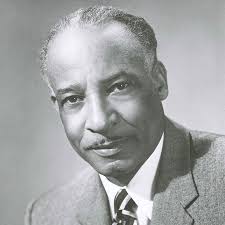Childhood
William Dawson was born on September 26th, 1899, in Anniston, Alabama to Eliza Starkey and George Dawson. In 1912, Dawson ran away from home to study music at the Tuskegee Institute under the tutelage of school president Booker T. Washington. Dawson paid his tuition by being a music librarian and manual laborer working in the school’s Agricultural Division. He also participated as a member of Tuskegee’s band and orchestra. He had learned to play most of the instruments by the time he graduated from the high school division in 1921.
College
When Dawson graduated from Tuskegee, he spent a year at Washburn College in Topeka, Kansas and directed the music program at the Topeka Vocational College. He worked that summer as tenor and trombonist with the Redpath Chautauqua. He enrolled at the Horner Institute of Fine Arts in Kansas City Missouri, where, in 1925, he earned his B.M. degree, but was not allowed on stage to receive his diploma. From 1922 to 1926, he taught at Lincoln High School in Kansas City, Kansas. From here he went to the American Conservatory of Music in Chicago (M.M., 1927), performing as first trombonist with the Chicago Civic Orchestra (1926-1930). After graduating, he studied with Carl Busch and Regina G. Hall. Dawson also did additional studies at the Eastman School of Music.
Early career
In 1928, Dawson’s wife Cornella Lampton died within the first year of their marriage. Dawson later remarried Cecile Nicholson in 1935. In September 1930, Dawson accepted Tuskegee Institute’s invitation to direct its School of Music, a position that he held until his retirement in 1955. Under Dawson's direction, Tuskegee’s 100-voice choir became a world-class ensemble best known for its headline-making performances at the grand opening of the Radio City Music Hall in New York in 1932. The choir performed that year at the White House for President Herbert Hoover and at Hyde Park, New York, for future president Franklin D. Roosevelt. In 1946, the choir broke the race barrier at Washington D.C.’s Constitution Hall as they became the first African Americans to perform there.
Negro Folk Symphony
Dawson’s compositions included chamber works such as his “Trio for Violin, Cello and Piano,” performed by the Kansas City Symphony. His best orchestral and choral works were based on spirituals like his Negro Folk Symphony. Dawson began work on the Negro Folk Symphony while in Chicago. On tour with the Tuskegee choir in New York, he showed the manuscript to the conductor Leopold Stokowski, who made suggestions for its expansion. It was first performed by the Philadelphia Orchestra in 1934.
Later years & Death
William Levi Dawson died on May 2, 1990, and is buried at Tuskegee University.
